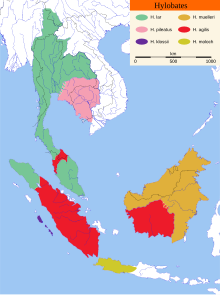The genus Hylobates /ˌhaɪloʊˈbeɪtiːz/ is one of the four genera of gibbons. Its name means "forest walker", from the Greek hūlē (ὕλη, "forest") and bates (βάτης, "one who treads").[3][4]
| Hylobates[1][2] | |
|---|---|

| |
| Apileated gibbon (Hylobates pileatus) female hanging from tree | |
| Scientific classification | |
| Domain: | Eukaryota |
| Kingdom: | Animalia |
| Phylum: | Chordata |
| Class: | Mammalia |
| Order: | Primates |
| Suborder: | Haplorhini |
| Infraorder: | Simiiformes |
| Family: | Hylobatidae |
| Genus: | Hylobates Illiger, 1811 |
| Type species | |
| Homo lar [1] Linnaeus, 1771 | |
| Species | |

| |
| Distribution of Hylobates and its species (note: Bornean population formerly included in H. agilis is now generally considered a separate species, H. albibarbis; H. muelleri is now split into H. muelleri, H. abbotti, and H. funereus) | |
It was once considered the only genus, but recently its subgenera (Hoolock [formerly Bunopithecus], Nomascus, and Symphalangus) have been elevated to the genus level.[1][5] Hylobates remains the most species-rich and widespread of gibbon genera, ranging from southern China (Yunnan) to western and central Java.
Individuals within this genus are characterized by 44 chromosomes and often have a ring of white fur around their faces.[2]
Hybrids between Müller's gibbon (H. muelleri) and the Bornean white-bearded gibbon, (H. albibarbis) have been reported in areas of Borneo.[6] A gibbon born at the Kujukushima Zoo in Japan to a female lar or white-handed gibbon (H. lar) was determined to have been fathered by a male agile gibbon (H. agilis).[7]